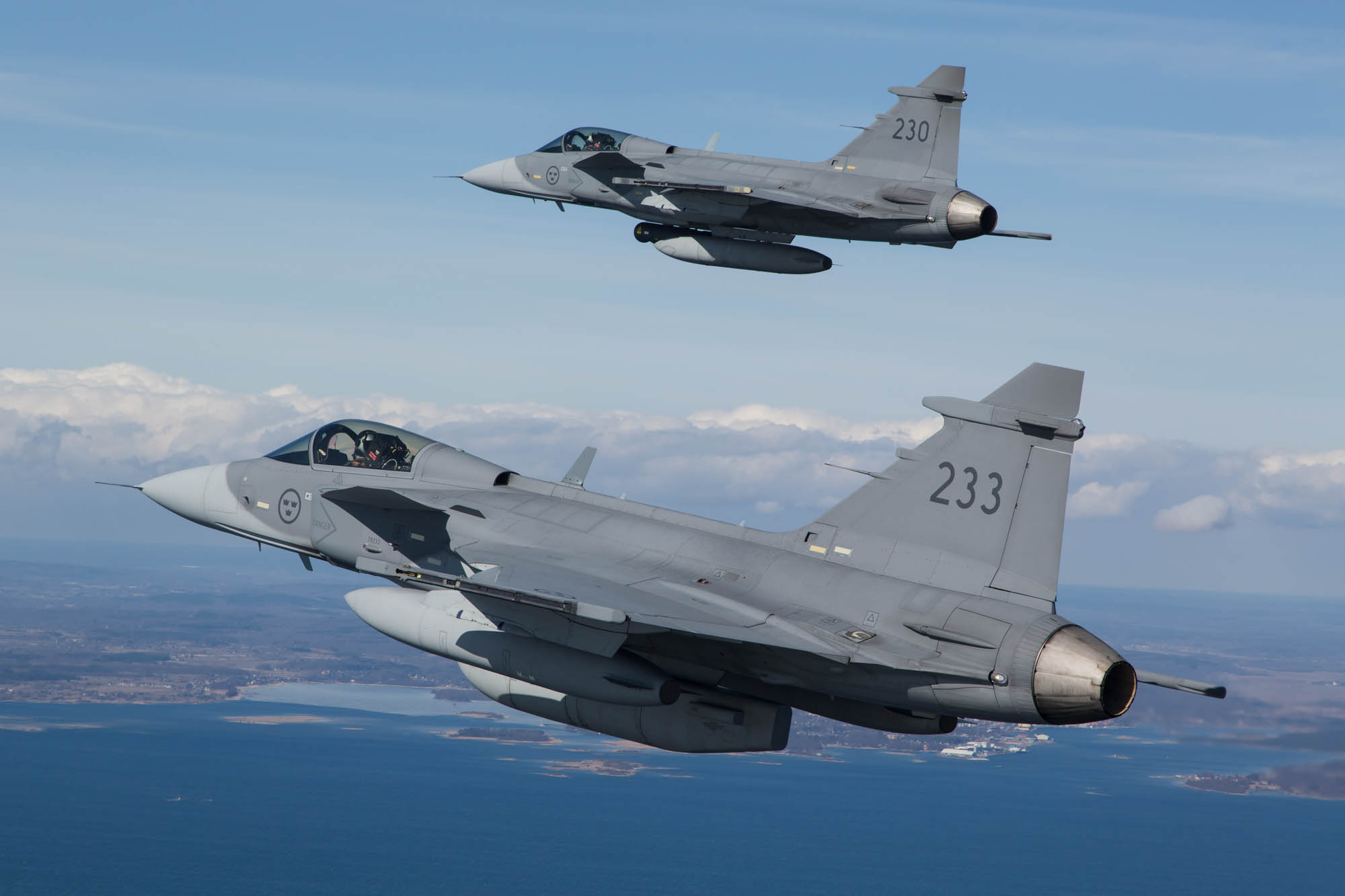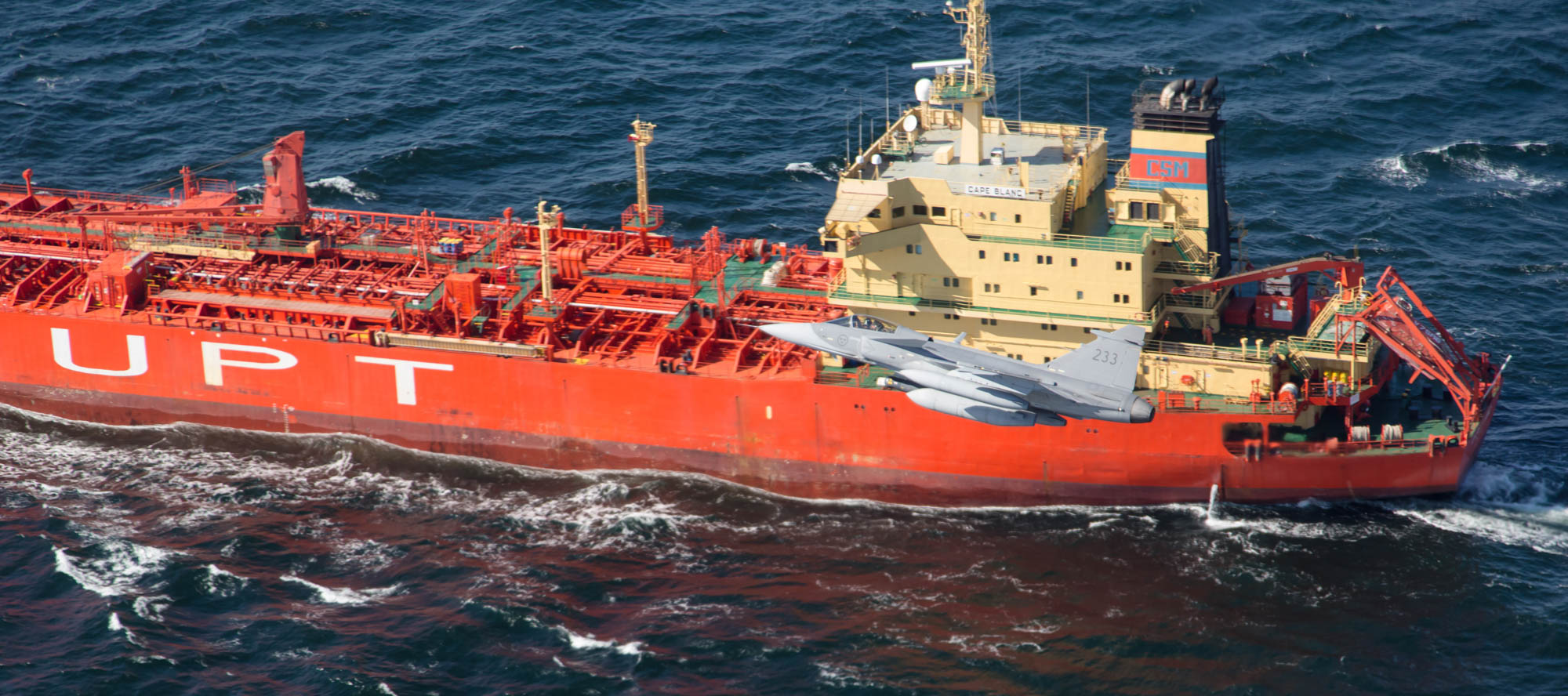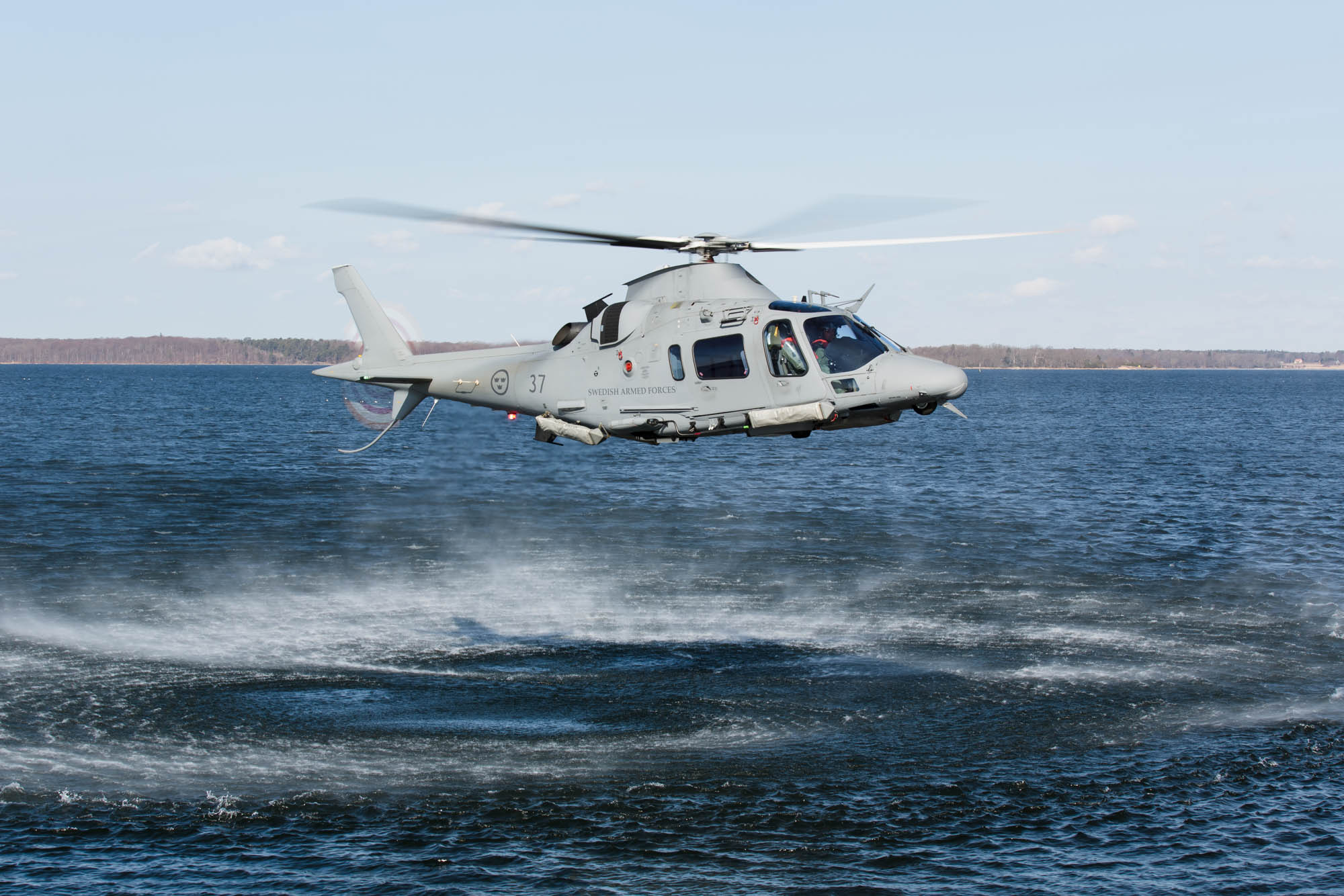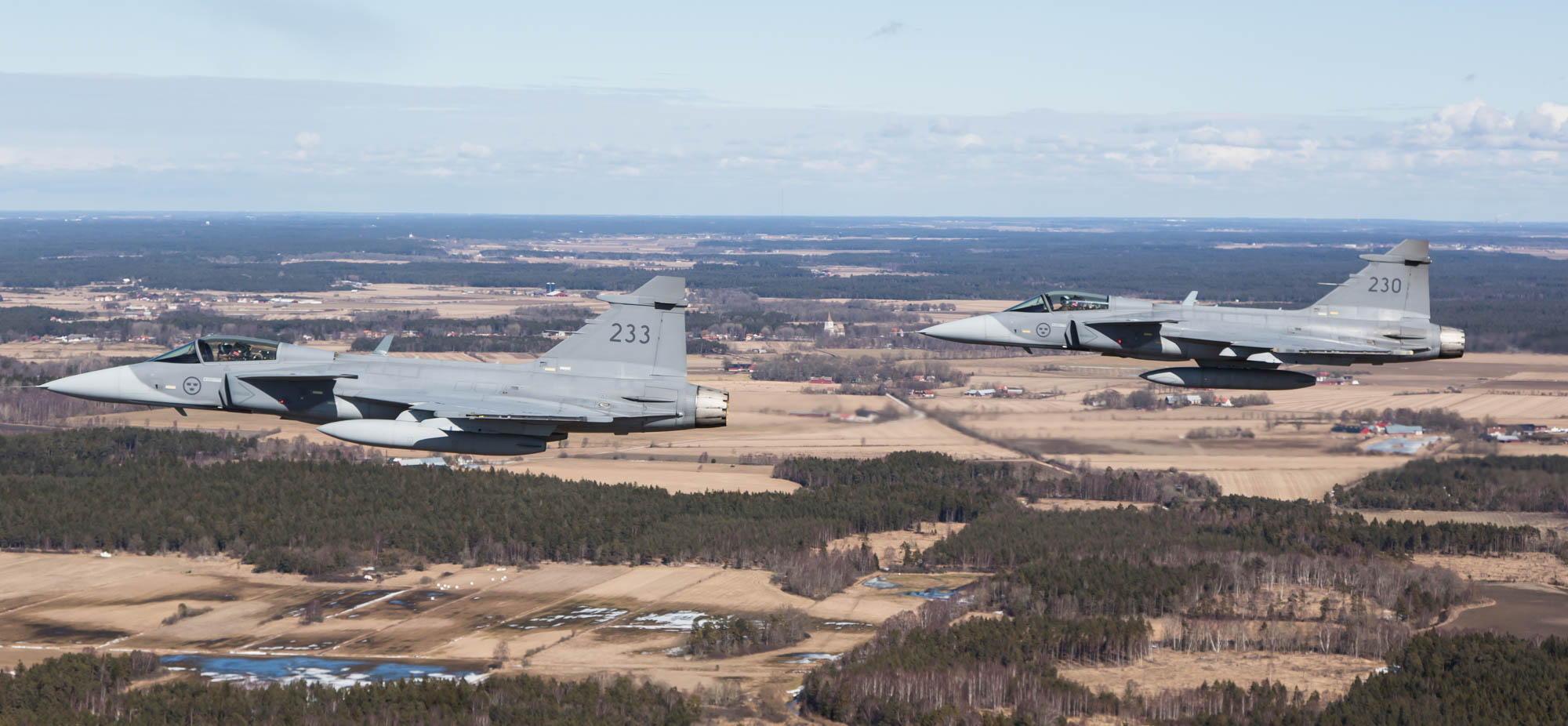|
|
|
|
| Low-Level Photography Reports Linkoping 2014 Ronneby 2013 |
| Low-Level Flying Photography Gripens Look East Suspicious Minds |
 |
| "Usually, students are lost in the second year when the air combat one-versus-one starts and three-dimensional thinking begins" Above: Saab JAS 39C Gripen (39233 '233') of F 17 Wing at Ronneby, it is fitted with a Rafael Litening III Targeting pod on the forward pylon and Saab Avionics developed SPK-39 Spaningskapsel 39 Modular Reconnaissance Pod System - MRPS) on the centreline pylon. Photo-reconnaissance and identification missions of shipping for intelligence gathering purposes are flown in cooperation with the Royal Swedish Navy and Swedish Coast Guard. |
The Swedish weather often dictates when phases in the course can be flown and completed. Low flying training starts in the summer and gives way to aerobatics at higher altitudes in preparation for air combat training with the onset of winter. Flygvapnet’s two front line fighter wings constantly fly missions in protection of their coastline with reconnaissance sorties flown further over the sea to protect Sweden’s sovereignty and ATS training reflects the front line missions. Maj Rosenquist described a visual reconnaissance training task; “Students fly over the Baltic Sea to find a ship and certain manoeuvres around it and return with the name of the ship”. The 40 year old side-by-side Sk 60s are still equipped with hand held wet-film cameras which fit between the ejector seats for students to use during reconnaissance training exercises. Ice and air - Challenging the students Students progressing to the second year look forward to having an opportunity to ‘shoot’ down their instructors, however it is not as they imagined. Captain Klas Bäckström is aware how challenging the students find the air combat phase of their course, “Usually students are lost in the second year when the air combat one versus one starts and three dimensional thinking begins. They are expected to think a lot more on their own and the demands increase”. Incidentally the instructors play ice hockey against the much younger and assumed to be fitter students who they consistently and convincingly beat each time. Cpt Bäckström callsign ‘Shrek’ puts this challenge down to superior tactics. Instructors in the second year have one of the toughest jobs says Cpt Bäckström; “The students are doing the flying but you need to look around in the cockpit and outside to see what the other aircraft are doing while they are continuously pulling Gs. It is hard on the neck and back. When you are flying as a target for the students you have to let them get you in their sights, you are always looking backwards or using the mirrors. You can’t instruct them if you can’t see them”, he says.
After graduation the students transfer to F 7 Wing at Såtenäs where they spend a year of conversion training from the Sk 60 to the Gripen (step one) followed by the first part of their combat readiness training (step two). Step three is completed at their front line squadron to get them fully operational. Arriving at their chosen frontline squadron the training becomes more challenging, combining navigation with a low-level attack runs and using basic weapons systems. With the onset of winter and the resulting poor weather they have a break from low-level flying in favour of air combat training at high level including; fighter versus fighter dog fights and beyond visual range (BVR) training. In spring with the arrival of better flying conditions the squadron’s new pilots progress to close air support (CAS) missions and more complex scenarios. CAS missions are flown at medium or low-level, according to cloud cover and the prescribed threat level. Intelligence, surveillance and reconnaissance training follows, now students fly as singletons or as number two to a flight leader. “It is easier for the student flying on their own, they can just focus on their own aircraft, which they can’t do as a number two”, says Major Per Hård af Segerstad an experienced Gripen pilot with F 17 Wing. Lieutenant Colonel Anders Segerby - Wing Commander Flying, is in charge of all flying operations at F 17 he explained the role of his wing, “Some people don’t think it is politically correct to watch to the east to say we have a threat. I’m a realist if I was to define a threat within our northern area it’s probably going to come from the east”. The role of F 17 reflects the perceived threats to Sweden’s sovereignty, Lt Col Segerby explained, “The perception is that the likely threat to Sweden is by air and sea rather than by land. We have a long coastline and we do a lot of anti-ship training where we fly as low as possible to avoid detection aided by the curvature of the earth. |
 |
| Sea traffic sailing around Sweden's waters are investigated and photographed at close quarters, here 'Cape Blanc' an oil tanker owned by UPT and sailing under the Marshall Islands flag is innocently sailing out of the Baltic and on to the North Sea. |
| Hunting ships With coastline of 2,000 miles (3,218 km) to protect, Sweden has always monitored shipping from Russia and the former Eastern Bloc countries of Estonia, Latvia, Lithuania, East Germany and Poland sailing in the Baltic Sea. All shipping has to pass through the narrow straits between Sweden’s southern shores and Denmark if they are to reach the Atlantic Ocean and beyond. While the ‘Cold War’ has ended they still must be vigilant. Gripen pilots continuously fly maritime photo-reconnaissance and identification missions of shipping for intelligence gathering purposes. These missions can be in co-operation with the Royal Swedish Navy and Swedish Coast Guard.
For the reconnaissance intelligence gathering role the Gripen is fitted under its centreline with the Terma/SAAB Modular Reconnaissance Pod System (MRPS) designated the Spaningskapsel 39 (SPK-39). The MRPS is fully digitised and built around three main sub-systems; the sensor fit, the Digital Mass Memory and the Reconnaissance Management System it is interfaced with the aircraft’s avionics with day and night capability. It is housed in the ‘Strongback’ pod which has a 360 degree rotating window which is electronically synchronised to the sensor aiming system. The window can be positioned along any part of the mid-section allowing other sensors to be fitted in the pod. Lt Col Nelson spoke of intelligence gathering, “Normally we will have a ‘hint’ that a new vessel will be doing tests somewhere in the Baltic. Generally there are new maritime vessels coming out of the shipyards in the St.Petersburg and Kalingrad area as the Russian Navy is modernising. We work jointly with the Royal Swedish Navy; they are of course very interested in our pictures”. These flights are always conducted over International waters according to the Toronto Agreement.
Specific ships can be notified and targeted in Swedish waters beyond 12 nautical miles (22km) as well as in international waters in the Baltic and the Western Sea. Maj Hård would not be drawn on where the requests for intelligence could originate from only saying that, “The tasking makes it quite clear what you are looking for”. Stealthy intruders - Foreign Submarines in Swedish waters In October 2014 civilian photographs of a surfaced submarine were backed up by a sonar image released a month later to show that a foreign submarine had entered well in to Sweden’s territorial waters near to Stockholm. Naval vessels and aircraft scoured the area but could not identify the submarine or the country responsible. Suspicions fell on Russia but their defence ministry denied any of its ships were involved. Such reports are not unheard of, in 1981 a Soviet Navy Whiskey-class submarine (U137) complete with nuclear weapons ran aground near to the southern Swedish Naval base of Karlskrona it was released ten days later. There are numerous other reports of intruding submarines throughout the 1980s and again in 2011 when depth charges and mines were dropped. |
 |
| In 2008 six Agusta A109LUH-S designated Hkp15B were navalised for SAR and ASW duties. They are routinely utilised for surface surveillance and sea traffic control and additionally support land forces and are also required to act as targets over the sea for the Gripen pilots. |
| Helicopter support Since 1998 all Swedish military helicopters all come under the Swedish Armed Forces Helicopter Wing (Försvarsmaktens Helikopterflottilj), which is divided in to squadrons each with their own assigned duties and work in co-operation with the air force, army and navy. 3 Helicopter Squadron (Helikopterskvadronen – 3.HkpSkv) are assigned to F 17 Wing at Ronneby their role is to support naval operations using the AgustaWestland AW109MUH designated the Hkp15B. These six aircraft were part of an order for 20 Hkp15As delivered to Sweden in 2006 and navalised in 2008 for ship based operations including search and rescue (SAR) duties, they can also be equipped with sonar buoys for anti-submarine warfare (ASW). The Hkp15B mostly operates over the sea, performing surface surveillance and sea traffic control along the Sweden’s coastline. Combat air support (CAS) missions can be flown in conjunction with forward air controllers (FACs) flying in an Hkp15A/B helicopter flying low in the area. Lt Col Nelson spoke of the communications with the Gripen pilots, “The FAC will describe the target area, a town, small built up area or woodland perhaps. You can say you see a lake and then he can direct you from his map, for example saying south west times two the lakes length, there you will see small stream with an ‘S’ bend”. Precise coordinates can be given using the onboard Laser Designated Pod (LDP). Hkp15Bs are also required to act as targets over the sea for the Gripen pilots. Sweden continues to support the European Union Naval Force (EU NAVFOR) which set up ‘Operation Atalanta’ in 2009 to deter pirates and protect Somalia-bound vessels and shipments belonging to the World Food Programme (WFP) and the African Union Mission to Somalia (AMISOM) and protects other vulnerable shipments. 3.Hkpskv Commander Major Per Lundladh explained what their role, “We are operating in the Gulf of Aden onboard ocean patrol vessel HSwMS Carlskrona (M04) to deter pirates and if necessary stopping them using force”. Their first deployment was in 2010 and the second ran from April to August in 2013. Ship and helicopter deployments are currently being rotated with Italy, Spain and Germany with another dozen countries naval vessels involved. The EU mandate for the operation has recently been extended to December 2016. Remaining vigilant The Swedish people value their neutrality but with regular challenges by the Russian military and the threat of incursions in to their airspace and their territorial waters the military forces are kept constantly on their toes. A recent example of an incursion occurred on September 17, 2014 when two Russian Sukhoi Su-24 bombers were reported to have entered Swedish air-space possibly to test the capabilities of the air defence system. Sweden has not forgotten that in 1952 a Flygvapnet Douglas DC-3 on an Electronic Intelligence (ELINT) radio eavesdropping mission over international waters over the Baltic was shot down by a Soviet MiG-15. The wreckage was recovered in 2003 and eventually put on display at the Flygvapenmuseum at Malmslätt-Linköping, it is now a sober reminder of why Sweden has to remain vigilant. |
 |
| A pair of JAS39C Gripen on a low-level training sortie over the island of Gotland which is 56 miles (90 km) to the south east of Sweden. Visby airfield on Gotland is used most weeks as a hot refuelling base to extend the mission time and range or the combat radius during exercises. |